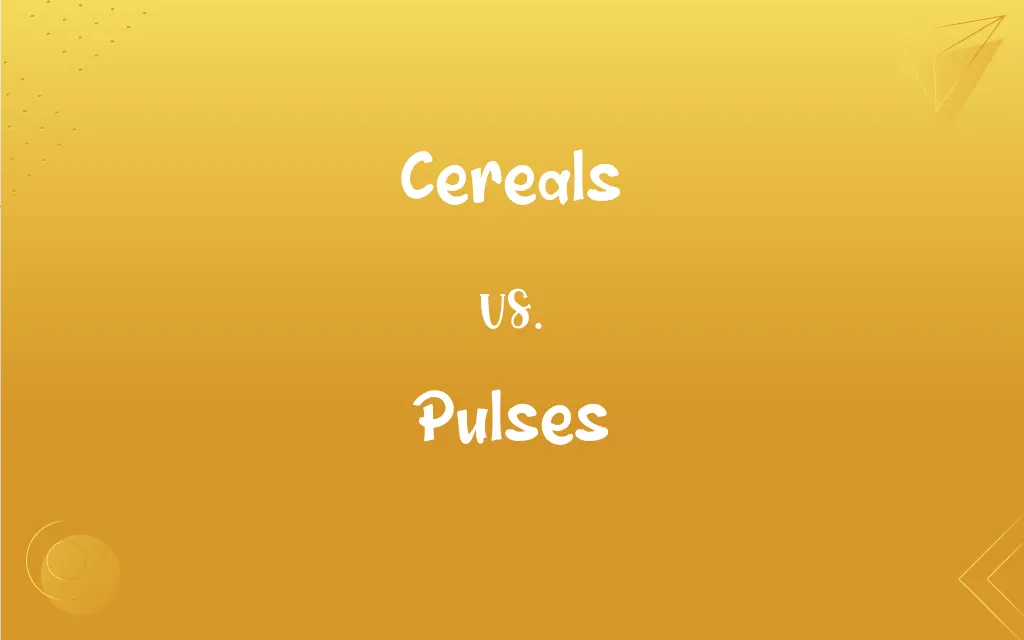Cereals vs. Pulses: What's the Difference?
Edited by Aimie Carlson || By Harlon Moss || Published on November 20, 2023
Cereals are grassy plants yielding edible grains, while pulses are edible seeds of leguminous plants.

Key Differences
Cereals refer to a category of grassy plants specifically cultivated for the grain they produce. These grains, rich in carbohydrates, form a substantial portion of the world's dietary energy supply. Pulses, on the other hand, pertain to the seeds of leguminous plants. They are rich in protein and often considered an essential protein source, especially in vegetarian diets.
In many cultures, cereals serve as a primary food source. They can be consumed in various forms such as whole grains, refined grains, or processed foods like bread and pasta. Pulses, with their protein richness, are often used to complement cereals, ensuring a balanced intake of essential amino acids. In several traditional dishes worldwide, the combination of cereals and pulses offers a complete protein profile.
Cereals include familiar grains like wheat, rice, maize, and oats. They are primarily energy-providing foods due to their high carbohydrate content. Pulses encompass lentils, beans, peas, and chickpeas, which are not only protein-rich but also provide dietary fiber, vitamins, and minerals, making them a nutritious addition to any diet.
It's essential to understand the distinctive characteristics of cereals and pulses, especially in agricultural contexts. While cereals are grasses, pulses belong to the legume family, which means they fix nitrogen in the soil, enhancing its fertility. This ability makes pulses a vital crop in crop rotation, benefiting subsequent cereal crops.
Comparison Chart
Definition
Grassy plants producing grains.
Edible seeds of leguminous plants.
ADVERTISEMENT
Nutritional Value
High in carbohydrates.
High in protein and fiber.
Examples
Wheat, rice, oats, maize.
Lentils, beans, peas, chickpeas.
Agricultural Role
Primary crops for human consumption.
Improve soil fertility via nitrogen-fixation.
Consumption
Consumed as grains or processed food.
Consumed whole, split, or processed.
Cereals and Pulses Definitions
Cereals
Primary source of dietary carbohydrates.
Consuming cereals for breakfast provides energy for the day.
ADVERTISEMENT
Pulses
Edible seeds from leguminous plants.
Chickpeas and lentils are popular pulses.
Cereals
Grassy plants yielding grains.
Wheat and rice are commonly consumed cereals.
Pulses
Nutritious seeds improving soil health.
Growing pulses can enhance the soil's nitrogen content.
Cereals
Edible grains harvested from specific grasses.
Many cereals like maize are staple foods worldwide.
Pulses
Protein-rich seeds of certain plants.
Vegetarians often rely on pulses for protein intake.
Cereals
Grains used in various processed foods.
Cereals are main ingredients in foods like bread and pasta.
Pulses
Non-grain seeds of legume plants.
Pulses like black beans are essential in many cuisines.
Cereals
Cultivated crops for their grains.
Many farmers grow cereals as they are in high demand globally.
Pulses
Consumed whole, split, or grounded.
Many dishes use pulses as their primary ingredient.
Cereals
A grass such as wheat, oats, or corn, the starchy grains of which are used as food.
Pulses
The rhythmical throbbing of arteries produced by the regular contractions of the heart, especially as palpated at the wrist or in the neck.
Cereals
The grain of such a grass.
Pulses
A regular or rhythmical beating.
Cereals
Any of several other plants or their edible seeds or fruit, such as buckwheat or certain species of amaranth.
Cereals
A food prepared from any of these plants, especially a breakfast food made from commercially processed grain.
Cereals
Consisting of or relating to grain or to a plant producing grain.
Cereals
Plural of cereal
FAQs
What are cereals?
Cereals are grains produced by grassy plants consumed as food.
What defines pulses?
Pulses are the edible seeds of leguminous plants.
Can you name some common cereals?
Wheat, rice, maize, and oats are examples of cereals.
Do cereals benefit the soil?
Unlike pulses, cereals don't fix nitrogen but are vital for human consumption.
Are cereals high in protein?
While cereals contain some protein, they're primarily high in carbohydrates.
Why are pulses and cereals often eaten together?
Together, they provide a balanced protein profile, offering all essential amino acids.
Are cereals gluten-free?
Some cereals like rice and corn are gluten-free, but wheat, barley, and rye contain gluten.
Do pulses contain gluten?
No, pulses are naturally gluten-free.
What are some examples of pulses?
Lentils, beans, peas, and chickpeas are typical pulses.
How do pulses benefit agriculture?
Pulses fix nitrogen in the soil, enhancing its fertility.
Is rice a pulse?
No, rice is a cereal.
Are oats considered pulses?
No, oats are cereals.
Can pulses be ground into flour?
Yes, many pulses like chickpeas can be ground into flour.
Are cereals and pulses seeds?
Yes, cereals are grains (seeds), and pulses are the seeds of leguminous plants.
Why are pulses considered protein-rich?
Pulses are a significant protein source, especially vital in vegetarian diets.
Are cereals legumes?
No, cereals come from grassy plants, while pulses are legumes.
Which is a richer fiber source, cereals or pulses?
Pulses generally contain more fiber than cereals.
What's the carbohydrate content in pulses?
While pulses have carbs, they're lower than cereals and are often rich in complex carbs.
Which is more diverse, cereals or pulses?
Both have diverse types, but pulses include a wider variety of species.
How are cereals typically consumed?
Cereals are consumed as whole grains, refined grains, or in processed foods.
About Author
Written by
Harlon MossHarlon is a seasoned quality moderator and accomplished content writer for Difference Wiki. An alumnus of the prestigious University of California, he earned his degree in Computer Science. Leveraging his academic background, Harlon brings a meticulous and informed perspective to his work, ensuring content accuracy and excellence.
Edited by
Aimie CarlsonAimie Carlson, holding a master's degree in English literature, is a fervent English language enthusiast. She lends her writing talents to Difference Wiki, a prominent website that specializes in comparisons, offering readers insightful analyses that both captivate and inform.






































































